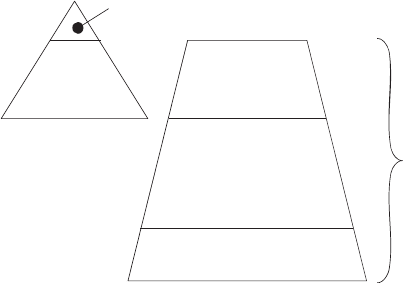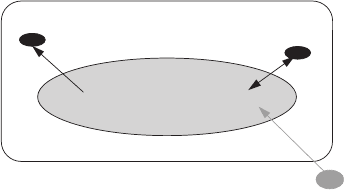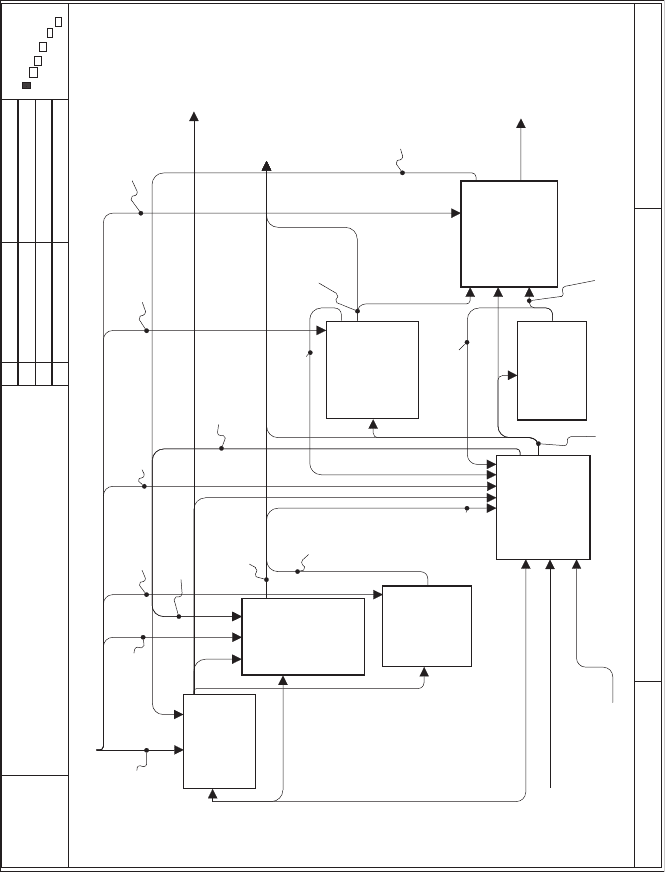Buede D.M. The Engineering Design of Systems Models and Methods
Подождите немного. Документ загружается.


Chapter 6
Requirements and Defining
the Design Problem
6.1 INTRODUCTION
Requirements are the cornerstone of the systems engineering process: Stake-
holders’ requirements provide operational statements by the stakeholders
concerning their needs; derived requirements enable the engineers of systems
to partition the design problem into components that can be worked in parallel
while maintaining design control through the requirements pa rtition and the
interfaces between the components; derived requirements enable the verifica-
tion of the configuration items and components during the qualification activity
during development; and stakeholders’ requirements provide the means for
validating the system’s design during qualification.
Requirements do not just show up on the systems engineer’s desk. Obtaining
‘‘good’’ requirements is critical to the successful engineering of a system [Blum,
1992, pp. 68–81; Davis, 2005, pp. 3–39]. The systems engineer must work hard
with the stakeholders of the system to develop the requirements. Fortunately,
there is a tried and true method with some valuable modeling techniques that
can be used in this effort.
There are few references that provide a coherent view of the systems
engineering process for developing stakeholders’ requirements for a system,
including a definition of how these requirements might be usefully character-
ized to aid the generation process. Grady [1993] provides an excellent discus-
sion of what requirements are, how requirements should be written one at a
time and in documents, and how requirements should be allocated. Faulk et al.
The Engineering Design of Systems: Models and Methods, Second Edition. By Dennis M. Buede
Copyright r 2009 John Wiley & Sons, Inc.
151
[1992] describe a software engineering method for real-time requirements that
has many of the characteristics that are important. Crowe et al. [1996] adapt the
method of Faulk et al. [1992] to software-intensive systems; however this
adaptation is incomplete because software engineering assumes systems en-
gineers are their interface to the stakeholders. However, no reference found by
the author discusses systematically how requirements should be de veloped and
how such constr ucts as the operational concept, prototyping, objectives
hierarchy, and external systems diagram can be used in this process. This
chapter (an expansion of Buede [1997]) defines such a process that is consistent
with most systems engineering practice.
This chapter begins by discussing what requ irements are. Definitions that are
key to putting a system in its context with external systems and the environment
are provided next. Section 6.4 defines the process or method by which
requirements are developed. A discussion of various categories of requirements
found in the literature of systems engineering are then discussed, followed by
the partition of requirements that will be used in this book. The proposed
outline for a stakeholders’ requirements document that addresses all phases of
the system’ s life cycle is provided in Section 6.7. The literature on requirements
has proposed a number of characteristics that define either a sound individual
requirement or a set of sound requirements; these characteristics of sound
requirements are given in Section 6.8. The convention for writing requirements
is discussed in Section 6.9.
Sections 6.10 to 6.13 describe in detail the portions of the process for
developing requirements: defining the operational concept for each phase of the
system’s life cycle, creating an external systems diagram for each phase of the
life cycle, establishing an objectives hierarchy for each phase of the life cycle,
and conducting prototyping and usability testing to analyze the potential
requirements in each phase of the life cycle. Section 6.14 provides a detailed
discussion of the four segments of the requirements partition for each pha se of
the life cycle: the input/output requirements, the system-wide and technology
requirements, the trade-off requirements, and the qualification requirements.
Finally, the issue of managing requirements during the development of a
system is discussed.
The focus of this chapter is the method for defining requirements for a
system and all of the systems associated with each phase of the system’s life
cycle. There are seven activities associated with this method: developing the
operational concept; defining the system boundary; developing an objectives
hierarchy; developing, analyzing, and refining the requirements (including
prototyping and usability testing); ensuring requirements feasibility; defining
the qualification system requirements; and obtaining approval of the
requirements.
Several models are introduced to suppo rt the process for defining require-
ments. A qualitative model, an input/output trace, is described for defining a
scenario that is part of the system’s operational concept. An application of
IDEF0 (Integrated Definition for Function Modeling) modeling is described
152 REQUIREMENTS AND DEFINING THE DESIGN PROBLEM
for defining the process of a system’s interaction with other (external) systems;
this external system diagram defines all of the inputs and outputs associated
with the system. A hierarchical decomposition of the objectives for a system is
another example of a qualitative model used in this requirements definition
process.
The exit criterion for this initial activity in the engineering of a system is the
approval of the requirements document by the stakeholders. Often the
engineers of a system are focused on obtaining this approval as quickly as
possible, often without defining all of the requirements suggested in this
chapter. The trade-off and qualification requirements are missing from most
requirements documents. The contention of this chapter is that the real exit
criterion of the requirements definition process is the approval by the
stakeholders of the accepta nce plan for the system. If the acceptance plan is
affirmed, then all of the other portions of the requirements document are
presumed to he defined in acceptable detail.
6.2 REQUIREMENTS
Many authors have defined the term requirement. The list below provides
several definitions that highlight key concepts (the italics are the author’s).
Sailor [1990]: identifiable capabilities expressed as performance measurables
of functions that the system must possess to meet the mission objectives.
MIL-STD 499B [Military Standard, 1993]: identifies the accom plishment
levels needed to achieve specific objectives.
Chambers and Manos [1992]: the attributes of the final design that must be a
part of any acceptable solution to the design problem.
Grady [1993]: an essential attribute for a system or an element of a system,
coupled by a relation statement with value and units information for the
attribute.
Davis [2005]: an externally observable characteristic of a desired system.
The requirements for a system set up standards and measurement tools
for judging the success of the system design. These requirements should
be viewed hierarchically. At the top are mission-level requirements that
establish how the stakeholders will benefit by introd ucing the system in
question into the supersystem of the system. These mission requirements relate
to objectives of the stakeholders that are defined in the context of the
supersystem, not the system itself. For example, Boeing identified two primary
mission requirements when starting on the Boeing 777 commercial aircraft: trip
cost per seat and total trip cost. Each airline company that purchases a 777 is
the meta-system that most influences an aircraft company during the develop-
ment phase.
6.2 REQUIREMENTS 153

Stakeholders’ requirements are developed next in the context of these mission
requirements and should focus on the boundary of the system. If the
stakeholders’ requirements are defined inter nally to the system, the risk of
having design statements embedded in the requirements goes up substantially.
A major emphasis of this chapter is that the stakeholders’ requirements should
be as design independent as possible. Boeing’s stakeholders’ requirements for
the 777 included such topics as liftable weight of the aircraft at specified
conditions, the empty weight of the aircraft, the drag force on the aircraft for
certain specified flight conditions, and the fuel consumption of the aircraft at
certain specified flight conditions.
As discussed in Chapter 1 system requirements are a translation (or
derivation) of the stakeholders’ requirements into engineering terminology.
Once this translation occurs, the derivation process of requirements continues.
Recall from Chapter 1 that the goal of the design process is to create a system
specification that can be developed into specifications for the system’s compo-
nents, which are then segme nted into specifications for the system configuration
items (CIs). As a result the design process creates two hierarchies of require-
ments as shown in Figure 6.1.
The stakeholders’ requirements are produced in conjunction with the
stakeholders of the system, based upon the operational needs of these
stakeholders. Some systems engineers believe the systems engineering process
begins when the Stakeholders’ Requirements Document (StkhldrsRD) arrives;
however the position taken here and supported by Pragmatic Principle 1 [De
Foe, 1993] of the International Council on Systems Engineering (INCOSE) is
that the systems engineers must be involved with the stakeholders to have any
hope of producing a useful StkhldrsRD; note italicized items. In fact, the
process described in this chapter is focused on methods and models for
developing a valid and complete StkhldrsRD.
Mission Requirements
Stake-
holders’
Requirements
System
Requirements
Component
Requirements
CI
Requirements
Derived
Requirements
FIGURE 6.1 Requirements hierarchies.
154
REQUIREMENTS AND DEFINING THE DESIGN PROBLEM
The Systems Requirements Document (SysRD), which is derived from the
StkhldrsRD, is a translation from the language of stakeholders to the language
of engineer s. The system’s requirements are traced directly from the stake-
holders’ requirements.
Note the term stakeholder is used in the above discussion in place of the
more common term user. This is to emphasize the fact that there are usually
multiple categories of users of a system: owner and/or bill payer, developer ,
producer or manufacturer, tester, deployer, trainer, operator, user, victim,
maintainer, sustainer, product improver, and decommissioner. Each stake-
holder has a significantly different perspective of the system and the system’s
requirements. If one perspective is singled out as the only appropriate one, the
developers of the syst em will miss key information, and the system will be
viewed negatively or as a failure from the other perspectives.
The systems engineering process for creating a system design is decision rich.
That is, the systems engineer is searching via a great deal of analysis and
experience to find a very good (optimum is usually not possible to determine)
solution that satisfies all of the mandatory requirements of the stakeholders and
delivers as much performance as possible within the guidelines of cost and
schedule.
This search process involves making man y decisions about the system’s
physical character (or resources) and allocations of functions to resources that
are usually only revisited if absolutely necessa ry. This search process occurs as
the top-down onion-peeling process of systems engineering occurs. Figure 6.1
shows derived requirements at the component level (which may be several
layers of the onion) and the CI (or bottom) level. Chapters 7 through 10 will
describe this process of architecture developm ent and creation of appropriate
derived requirements, supported by analysis and judgment. To continue the
story of the Boeing 777, Boeing created requirements for a major subsystem of
the 777 — the engine. These derived requirements for the engine included the
weight of the engine (derived from the weight of the empty aircraft), the thrust
of the engine at specified conditions (derived from the liftable weight of the
aircraft), the drag of the engine at specified conditions (derived from the drag of
the aircraft), and the fuel consumption of the engine at specified cond itions
(derived from the fuel co nsumption of the aircraft).
A major impediment to this design process being successful is the over-
constraint of the solution space by the stakehol ders’ requirement s. The systems
engineers job is to work with the stakeholders to define the stakeholders’
requirements so as to make sure that there is significant design freedom within
these requirements and that many feasible designs exist. Stakeholders and (all
too often) engineers are willing to constrain the requirements space very tightly
without fully understanding or appreciating the potential value of the design
options that they are eliminating. The stakeholders’ requirements process
defined in this chapter takes explicit account of this need to have and define
a large tradabl e region in design space for the systems engineers to search with
quantitative techniques utilizing the priorities of the stakeholders.
6.2 REQUIREMENTS 155
Pragmatic Principle 1 [DeFoe, 1993] Know the Problem, the Customer, and
the Consumer
1. Become the ‘‘customer/consumer advocate/surrogate’’ throughout the
development and fielding of the solution.
2. Begin with a validated customer (buyer) need — the problem.
3. State the problem in solution-independent terms.
4. Know the customer’s (or buyer’s) mission or business objectives.
5. Do not assume that the original statement of the problem is necessarily the
best, or even the right one.
6. When confronted with the customer’s need, consider what smaller objec-
tive(s) is/are key to satisfying the need, and from what larger purpose or
mission the need drives; that is, find at the beginning the right level of
problem to solve.
7. Determine customer priorities (performance, cost, schedule, risk, etc.).
8. Probe the customer for new product ideas, product problem/shortfalls,
identification of problem fixes.
9. Work with the customer to identify the consumer (user) groups that will be
affected by the system.
10. Use a systematic method for identifying the needs and solution preferences
of each customer group.
11. Don’t depend on written specifications and statements of work. Face-to-
face sessions with the different customer/consumer groups are necessary.
12. State as much of each need in quantified terms as possible. However,
important needs for which no accurate or quantified measure exists still
must be explicitly addressed.
13. Clarify each need by identifying the power and limitations of current and
projected technology relative to the customer’s larger purpose, the
environment, and ways of doing business.
6.3 DEFINITIONS
Before discussing the process for developing stakeholders’ requirements, the
definitions presented in Chapter 2 are reviewed.
A system is a set of components (subsystems, segments) acting together to
achieve a set of common objectives via the accomplishment of a set of tasks.
A system task or function is a set of functions that must be performed to
achieve a specific objective.
A h uman-designed system is (a) a specially defined set of segments (hardware,
software, physical entities, humans, facilities) acting as planned (b) v ia a
156 REQUIREMENTS AND DEFINING THE DESIGN PROBLEM

set of interfaces, which are designed to connect the components, (c) to
achieve a common mission or fundamental objective (i.e., a set of
specially defined objectives), (d) subject to a set of constraints, (e) through
the accomplishment of a predetermined set of function s.
The external systems [Levis, 1993] of a system are a set of entities that
interact with the system via the system’s external interfaces. Note in
Figure 6.2, the external systems can impact the system and the system
does impact the exter nal systems. The system’s inputs may flow from
these external systems or from the context, but all of the system’s outputs
flow to these external systems. The external systems, many or all of which
may be legacy (existing) systems, play a major role in establishing the
stakeholders’ requirements.
The context [Levis, 1993] of a system is a set of entities that can impact the
system but cannot be impacted by the system. The entities in the system’s
context are responsi ble for some of the system’s requirements. See
Figure 6.2. Wieringa [1995] uses the phrase ‘‘universe of discourse’’ to
label the context and external systems that part of the world about which
the system registers data and controls behavior.
6.4 STAKEHOLDERS’ REQUIREMENTS DEVELOPMENT:
DEFINING THE DESIGN PROBLEM
Developing a good and complete set of requirements is very difficult. First, we
have to figure out what topics we should be writing requirements about. These
topics for the system-level requirements should all be at the same level of
granularity, a level of granula rity that is consistent with the system-level and
not the meta-system or subsystems. To facilitate defining these topics we will
introduce the concepts of an operational concept, external systems diagram,
and objectives hierarchy.
System
External Systems
Context
are impacted by “System”
impacts, but not impacted by, “System”
FIGURE 6.2 Depiction of the system, external systems, and context.
6.4 STAKEHOLDERS’ REQUIREMENTS DEVELOPMENT: DEFINING THE DESIGN PROBLEM 157
After we determine what the topics of the requir ements conversation are
going to be, we can start writing specific requirements. Now we have to
determine what we want to say in that requirement. What is the threshold we
are going to set for the minimum level of acceptable achievement? Here we will
talk about prototyping, analysis, elicitation, and usability testing.
Next the requirements should be analyzed to determine that at least one
feasible solution exists. A common problem is that we have defined thou sands
of requirements and together they are so constraining that there is no solution
with enough performance at a low enough cost and a quick enough schedule.
Often it is very difficult to determine that there is a feasible solution so this step
is skipped. Typically the selected design proves to be insufficient for 5 to 20
requirements, meaning it was not a feasible solution. Late in the design process
systems engineers are confronted with the problem of should we search for a
new design or accept the fact the current design cannot meet all of the
requirements.
The last step before approval should be defining qualification or test
requirements that are appropriate for the level of requirements being defined.
When defining system-level requirements these qualification requirements
should address how will system-level verification and validation be done.
So the seven functions of this stakeholders’ requirements development
process are:
1. Develop operational concept
2. Define system boundary with external systems diagram
3. Develop syst em objectives hierarchy
4. Develop, analyze, and refine requirement s (stakeholders’ and system)
5. Ensure requirements feasibility
6. Define the qualification system requirements
7. Obtain approval of system documentation
These seven functions are shown in an IDEF0 diagram in Figure 6.3. This
diagram is taken from the IDEF0 model of the process for engineer ing a system
in Appendix B. To define this process fully, the first three functions must be
defined in meaningful terms to justify their presence and provide explicit inputs
to the fourt h function. The last three functions are important but follow-on
from the development of the StkhldrsRD. The resource that performs
these functions is the systems engineering team; this resource is not shown in
Figure 6.3 to improve the readability of the IDEF0 diagram.
The operational concept is prepared from the perspective of the stakeholders
of the system and describes how these stakeholders expect the system to fit into
their world that contains a number of external systems and has a certain
context. The objectives of each stakeholder group are suggested here. The
operational concept defines the system and external systems in very general
terms (often as a block diagram) and establishes a use ca se diagram and the
158 REQUIREMENTS AND DEFINING THE DESIGN PROBLEM

USED AT:
CONTEXT:
NODE: TITLE: NUMBER:
AUTHOR: Dennis Buede
PROJECT: Engineering Design of a System
NOTES: 1 2 3 4 5 6 7 8 9 10
DATE: 05/24/99
REV:
WORKING
DRAFT
RECOMMENDED
PUBLICATION
READER DATE
P. 6
Originating & System
Requirements,
Objectives Hierarchy,
Boundary & Qualification
System Requirements
System-level
Operational
Concept
Design
Changes
Lower
Layer
Changes to
Require-
ments
Develop
Operational
Concept
A1111
Define
System
Boundary
with an
External
Systems
A1112
Develop,
Analyze and
Refine
Requirements
A1114
Obtain
Approval of
Requirements
Documentation
A1117
Requirements
Issues
Stakeholders' & System
Requirements
System
Boundary
Define
Qualification
System
Requirements
A1116
Qualification
System
Requirements
Develop
System
Objectives
Hierarchy
A1113
Objectives
Hierarchy
System
Boundary &
Objectives
Hierarchy
Stakeholders'
Constraints
Stakeholders'
Objectives
Ensure
Requirements
Feasibility
A1115
Proven Requirements
Feasibility
Proven Requirements
Infeasibility
Qualification
System Issues
Inputs of Stakeholders
Stakeholders'
& System
Requirements
Approval or
Disapproval
Qualification
Constraints
Stakeholders'
Uses
Stakeholders'
Jurisdiction
Allocated Architecture
Changes to Requirements
Engineers'
Requirements
Issues
Stakeholders'
Requirements
Issues
x
GMU Systems
Engineering
Program
Define System-Level Design ProblemA111
FIGURE 6.3 IDEF0 diagram of the system-level design process.
159
associated usage scenarios as sequence diagrams. These usage scenarios
describe ways in which the stakeholders will use the system as well as
interactions between the system and other systems. These scenarios define
inputs to and outputs of the system. In addition, the operational concept
includes the mission requirements for the system.
The second step, creating the external systems diagram, makes the bound-
aries between the system and external systems clear, leaving no doubt in
anyone’s mind wher e the system starts and stops. The development of this
diagram and the explication of the system’s boundaries are nearly always
harder than most people expect. As part of defining the system’s boundaries, all
of the inputs to and outputs of the system are established, as well as the external
system or context with which each input and output is associated.
The third step clarifies the objectives of the stakeholder groups and
formulates a coherent set of objectives for the system. Again, the output of
this step looks like it could have been created in a few hours, but generally takes
days if not weeks. Each objective is part of the value system of one or more
stakeholders for determining their satisfaction with the system. Naturally these
objectives conflict with each other in the sense that gaining value on one
objective (e.g., availability) means it will be necessary to give up value on
another objective (e.g., cost).
The creation of the stakeholders’ requirements, followed by the translation
of these requirements into system requirements, is the fourth step. The
stakeholders’ requirements are created by an analysis of the operational
concept for system functions, an exhaustive examination of the system’s inputs
and outputs, the specification of interfaces of the external systems with which
the system must interact, a thorough examination of the system’s context and
operational concept for system-wide and technology constraints, a detai led
discussion with the stakeholders to understand their willingness to trade-off a
wide range of non-mandatory but desirable system features, and the complete
specification of qualification requirements needed to verify and validate the
system’s capabilities from the stakeholders perspectives. Often a simulation
model that depicts some or all of the interaction between the system and one or
more other external systems is developed. These simulation models often
address timing issues, specific performance issues, reliability or availability,
safety and security, or quality of inputs and outputs. Cost analyses of a system
should be done with the context in which the system is going to operate in mind.
An important tool used during requirements development is prototyping, the
development of replicas of the parts of the system. For user interfaces this
prototyping is particularly important because users often do not know what is
possible with new technology or how they might use this new technology
effectively. For prototyping of user interfaces to be effective some form of
usability testing is commonly used to determine how the users function with the
prototype.
Before proceeding too far into the design process, these requirements must
be examined to ensure that a feasible design exists that meets the requirements.
160 REQUIREMENTS AND DEFINING THE DESIGN PROBLEM
